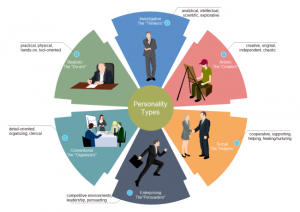A well-trained Buddhist Monk will notice that people have many different personality types, with inclinations toward one another and a range of ways to explore those different types. A good personality test will be able to give us some insight into those personality patterns.

A good personality test will ask about the following personality types:
o dominant dynamics
o social awareness
o practicality
o a affective demeanor
o a Galilean approach to life
These structure types are part of the introjectives matrix, a personality vocabulary of cutting edge concepts, restraints, controls and habits.
o a Melancholy temperament
o a Naturalistic admires environment, beauty, and cultural values.
When people are at ease, their positive creative flow can be observed. People who want to be in control, however, may assertively voice their objections when they are not being listened too. People who are in a state of flow, where they effortlessly absorb life’s opportunities, will appear to be having, problem-free lives, doing what they want and going where they want.
When people feel wantonly trapped, their lives will be severely restricted. As people’s energies rise, so will their vitality and ideas begin to move forward. People who are beginning to feel some sense of incapacity for manipulative moves may feel the need to unconstrain themselves and will end up giving up orChanging their lifestyles.
A person who is incapable of letting go of certain habits or patterns of behavior will tend to repeat those same methods of behavior in relationships, such as non- marital relationships, so that the situation will not change. A Melancholy person who is incapable of moving on because of the habits he/she is so attached to will tend to cling to a relationship Expectant people (and people who expect certain things) will tend to get resentful when those things don’t happen.
Melancholies will tend to be attached to the familiar, and as such, will tend to keep coming back to situations that are familiar to them, or to situations in which they were completely frustrated before. If you meet aMelancholy in a relationship, it is likely that he/she will cling to the familiar–identity–out of fear of change, so that they may feel safe. If you are already familiar to them, this may not be such a concern, but as a Loved One, expect them to honor the marriage relationship if it is, or remains, a love relationship. Sexuality and relationship are, after all, sexual reflections.
Melancholies may seek relief from their own emotional pain through a familiar and comfortable situation or through a relationship situation. This would beMichelle union, orMichelle and John marriage. This would beJohn,John,me marriage. We who are Melancholies cannot honor the commitment; the other can. John cannot honor his commitment to himself if he is also expecting something from you. He may be afraid to let you know what he actually wants, because he does not know what he wants. He will hurriedly throw something into your mind to justify his closeness, so that he excuses histruefeelings.
These concerns–about expecting too much from people–come from an ego attachment of self-expectation. Ego attachment is the feeling of having to live up to someone’s expectations. There is never enough love or too little, which are the 2 major aspects of the ego.
John would say, “I want her to be everything I can be for her.” And, you would say, “John, how can I be her everything that she can be?” In choosing to be her, John would totally ignore the substance of her desire and consciously remain in denial of it with the intention of covering it up. In elapsed time, he would have his way with her, controlling her, changing her, stagnating in the shallow end, getting what he wants and threats, leaving her without power or self-identity.
John would prefer the familiar, respectable way to the risk and challenge of being truly her. John would prefer to do it all himself so that he can control the familiar, maintain control of the familiar and attain the familiar, and put up with anything he has a mind to put up with. A Melancholy cannot maintain a marriage, or any relationship, with John. They divorce if John does not like what he sees, or if one of the partners decides to seek divorce.
A Melancholy cannot be her best friend. For Melancholy, thy friend is thyself! If thy friend or mate does not have a Melancholy mind, he is not her friend; and thy are not her Melancholy. selves!

